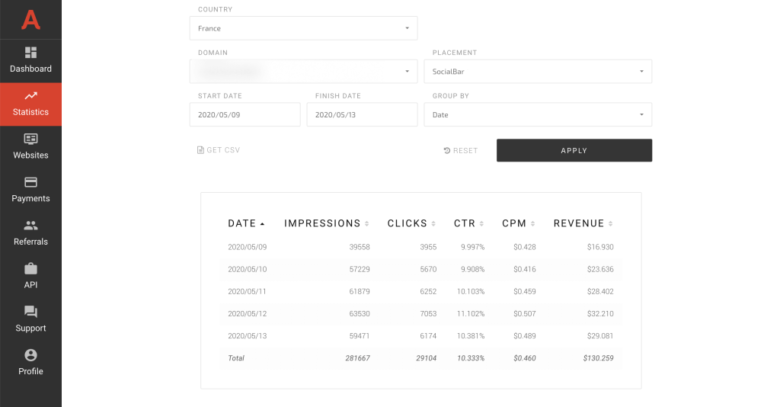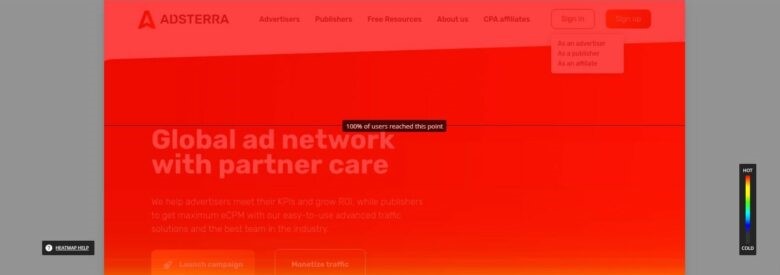Are you often left wondering, “why is my CPM so low”? Well, then you’ve come to the right place!
After working with a wide variety of publishers for several years, we’ve come to realise that the mistakes that separate them from growth and astronomical profits can often be fixed in a few minutes. This is why we created this checklist - we hope it can help you boost your CPM without breaking a sweat.
10 critical website monetization mistakes
Now, let’s take a look at the most common mistakes publishers make that prevent them from boosting their profits. We will provide some examples using our platform, Adsterra, but the advice we give can be applied on any ad network.
1. You tunnel vision CPM
A mistake many publishers make is only ever focusing on CPM. The profit you get from your ads is comprised of more than just that one metric, and while a low CPM may give you a sign that you need to rethink your strategy, it doesn’t always accurately reflect the full picture - especially since there could be more than one reason why it dropped.
Publisher stats are the key to getting the most out of your platform. Check your GEOs, CTRs, impressions, and don’t forget to check out how your competitors are doing. Successful campaigns are more than just your CPM, you also need good user retention rates, fitting traffic, and so on. It can seem overwhelming at first, but once you gain more experience and do some research, it will become easier to pinpoint what exactly you should pay attention to to stay on top.

2. Never trying new things
Shaking up your routine is always a good idea. While classics like banners or popunders are unlikely to ever go out of style, they no longer perform as well as they used to. The industry is constantly evolving, and if you don’t keep up with the progress, you may be left behind. So try to shake things up from time to time - go for new ad formats, new strategies, and maybe even new ad networks!
An easy way to stay on top of the recent trends in advertising is using our next gen ad format Social Bar. Its native, interactive ads can fit almost every website and entice users to click on them without ever being annoying and obnoxious. It is UX- and AdBlock-friendly, making it a perfect choice for iOS traffic.
3. Placing too many ads on your website
The “more ads = more money” mantra belongs in the early 2000s. Nowadays, users can get annoyed even if they see just 2-3 ads, so placing them everywhere on your platform is a big no-no. The annoyance isn’t the only problem: many people have begun developing the so-called “ad blindness”, tuning out all those banners and pop-ups you oh so diligently place on your web page.
Additionally, often in their desire to make as much money as possible publishers focus too much on ads and too little on content. If advertisements on your website are drowning out the posts or videos users visit your platform for, then those people are less likely to come back and seek out your content again.
Overusing native ads
“Ok, so I shouldn’t place too many banners on a single web page, got it. Well, that’s easy! I’ll just go hard on native ads instead.”
Wrong. Overusing native ads can be just as counterproductive as placing too many banners. Obviously, native ads are designed to be less noticeable and obnoxious - but that doesn’t mean that they are completely invisible to users.
The appropriate density of native ads mostly depends on what platform you’re running. Some websites like video streaming platforms can afford to be more aggressive and place a ton of native ads on their web page, but if you’re running a blog, it’s better to not go over 3 ads per post.
We advise you to thoroughly research your niche and audience to accurately determine how many ads can be placed on your website, but if you need a starting point, read our article to learn more about native ads and get an instant CPM boost.
4. Ad format oversaturation
We always advise our users to mix and match ad formats to achieve maximum profit and CPM, but it’s important to not overdo it. You may think things will be fine since you only placed one or two ads of each type, but in reality, users will most likely be overwhelmed and lose any desire to visit your page again.
Imagine you’re in a horror movie, and you’ve just done your best to get away from Michael Myers… only to turn around the corner and run into Leatherface. That’s what your users may feel once they finally pause all the video ads and avoid banners only to get a popunder when trying to open a new tab. Try your best to not ambush your website visitors with ads - even if they do click on one of them accidently, they will do their best to avoid your platform afterwards.
Additionally, using too many different ad formats makes it difficult to assess their individual profitability. You need to be able to identify your top earners to make good money on ads.
Try using just one ad format at first, then add another and see the users’ reaction to it. Adsterra’s Publishers Statistics is an excellent tool for evaluating your campaigns and adjusting them, and if you ever need advice on what formats to choose, you can always contact our highly qualified managers.
💡Extra tips
-
Sometimes, using different ad formats isn’t that profitable. It all depends on what platform you’re running and what your audience is like. In such cases, customization is key! If you can only use banners, try experimenting with placement and sizes, e.g. place a bigger banner at the top of the page, a small and narrow one on the side bar, and so on. Just remember to not overdo it.
When you mix and match different ad formats, go for ones that are the most different from each other, both in terms of what they look like and how the user can interact with them. For example, combine native ads with pushes, Popunders with Social Bar, and so on.
5. Not using the right ad format for your niche
Research is the cornerstone of any profit you can make as a publisher. Do tests, study your users, readjust your strategies, and don’t be afraid to try new things.
Unless you’re using an ad format like Adsterra’s Smart Direct Link - a simple URL that you can put anywhere on your page - you will need to take your niche into consideration when choosing an ad format. Some web services like file converters can afford to put whatever they want on their web pages, but if you run a blog or an online marketplace, you have to be more careful and considerate. For example, go for the least intrusive formats like the aforementioned direct link or native banners if the main focus of your platform is educational content.
6. Choosing wrong ad formats for your traffic type
Just like you can use wrong ads for your niche, some publishers also sometimes forget to adjust their ad formats in accordance with their traffic type.
Mobile vs Desktop
This is one of those obvious mistakes that can easily bring you a hefty profit when fixed. Some publishers still don’t adjust their banner sizes to mobile devices, even when most of their traffic is mobile. Don’t be like those publishers, study your traffic and adjust your ads accordingly: 798×90px is traditionally used on desktop, while 320×50px is more fitting for mobile devices.
Web push notifications
We’re witnessing the dawn of traditional push notifications: they are now being blocked by browsers like Google Chrome and are completely banned on iOS devices. And even on other platforms, most pushes give users the ability to decline them.
Instead, a new hero has risen: in-page push ads. This ad format is AdBlock-friendly yet super effective, and works even with such hard-to-reach OS like iOS.
Pop-ups and interstitial ads
If your traffic mostly consists of Gen Z kids or young adults, it is not a good idea to use aggressive ads like pop-ups - these formats will just scare younger generations off. Pop-ups are also not recommended for mobile traffic - due to limited screen size, they will work as a barrier that prevents users from interacting with the web page. In most cases, those pop-ups also have annoyingly small “x” - close buttons - which may give you a click but can infuriate the user, making them never want to visit your page ever again.
Interstitial ads are a lot more user-friendly, and are even used by Google Ads Platform. That said, look for ones that feature the dynamic iFrame technology - it allows users to click on the widget, collapse it or change its size all while making sure the web page’s actual content remains visible and usable. Adsterra’s Social Bar offers such interstitial ads alongside other non-intrusive interactive formats.
7. Endless popunders
In most cases the frequency of pop ads is set by default, but it is also possible to change it. Some publishers crank up that number to the max, intent on showing as many ads as possible… which leads to a decrease in CPM and loss of valuable traffic. Nobody wants to run into a myriad of hidden tabs that will slow down your device when looking for ways to fix your keyboard or wanting to learn how to boil an egg.
Such ads are one of Adsterra’s specialties, so we’ve found the perfect frequency for displaying them: 4 popunders in 2 hours with 10-second delay in between them. Making pop ads appear more often may result in your CPM rates declining both in the short- and long-term. Your revenue will be boosted temporarily, yes, but it will most likely plummet soon afterwards once advertisers realise how many campaigns you’re running all at the same time.
8. Incorrect ad placement
So, you have just the perfect amount of ads on your website, and both their type and look fit your traffic and niche. But your CPM is still low... Why?
Well, one more thing you have to look out for is ad placement. We’ve already briefly touched on this topic before, but let’s take a closer look at it now.
First and foremost, you have to understand how ad impressions are calculated. For example, native banners must load for at least 51% on a user’s device. So make sure your users are ready to scroll the page until they finally meet a set of native banners. If you run a page where users are more likely to click on side pages, like a blog, then there is little point in placing too many ads on the main page, as website visitors are unlikely to spend much time there.
Research which spots on your platform are visible and which ones often get ignored. You may find a place that you would have otherwise overlooked that in reality performs excellently. Some tools that can help you with that are Google Behavior reports, which show the most visited pages, and various Heatmap and Scrollmap tools that will tell you all about user behavior on each page.

An example of a scrollmap.
9. Working with more than one ad network
Many beginner publishers try to work with multiple ad networks at the same time in an effort to make as much profit as they can or just because they can’t decide which one they want to go for. This practice, however, is likely to lead to losses in both the short- and long-term.
You never know how two or more scripts from different ad networks will interact with each other - it can go smoothly, but it is also just as likely to end in disaster, creating a conflict that affects your page speed and more.
10. Not taking full advantage of ad codes and scripts
Be extra careful when you copy ad scripts or make any adjustments to them. If you’re not confident in your coding skills, it’s better to ask a helpful manager for advice. If there’s a fatal mistake in your code, there may be no ads served on your web page, leading to zero CPM. Ads can even cause serious conflicts on your actual page if placed in an incorrect part of your HTML code.
Some beginner publishers also make the mistake of using the same script twice - don’t do this, as each script is unique, and if you copy paste it more than once, your stats will go haywire and you won’t be able to draw the correct conclusions.
This mistake is easier to avoid rather than fix. On Adsterra, each ad format comes with its own guide. Please read it carefully and place ad units precisely as recommended. For example, don’t place native ads between the “” tags.

5 more mistakes publishers make
The mistakes we just listed can be fixed rather easily yet they can drastically slow down your growth. But they’re not the only pitfalls you can fall into when creating your campaigns. Here are some additional mistakes publishers make that cost them a lot of money.
1. Not making use of alternative monetization strategies
While websites are still the backbone of the advertisement world, that may not last for much longer. Before they become obsolete, it will be a good idea to check out other monetization avenues. Give TikTok, Pinterest, Instagram, and others a try. At the end of the day, the most important skill you can have as a publisher is adaptability to change. Don’t neglect your email and affiliate marketing either - both still perform really well.
2. Choosing a bad hosting provider
Website loading speed is essential for user retention. If it takes a person more than 5 seconds to load your website while all others work normally, they will likely avoid your platform in the future. People have short attention spans nowadays, so they may even just close the tab if they don’t see the content they came for immediately.
Go for a hosting provider that is fast and has good tech support. You may go for a free provider when you’re just starting out, but once your traffic volume begins to grow, it’s better to switch to something a little more powerful and reliable. Check out our guide on how to choose a hosting service.
3. Optimizing your web page for users but not for search engine algorithms
Balance is everything when it comes to monetization. While you should focus on creating content and making sure users will want to visit your page again, you should not neglect your ads and SEO.
Be helpful by writing articles that actually make sense, but sprinkle in key phrases here and there. Create a web service that many people will need to use, like a file converter, but use plenty of ads on it - in an unobtrusive way, of course - to turn in a profit. Quality content that users want to come back to is celebrated by both search engines and your audience.
4. Neglecting your audience
Find your target audience… and focus on it. It’s good to branch out and try new things, but don’t alienate your core user base.
Obviously, you will have to find your target audience first. Research the market and see what’s trending right now, and create your content accordingly. Many publishers still chase outdated trends, like creating mp3 converters when most people nowadays stream music instead. Try to stay on top of the market and adjust your strategies according to the niche you decided to go for.
5. Driving fake or bot traffic or purchasing cheap non-target traffic
When it comes to traffic, most publishers think it’s quantity over quality, but they couldn't be further away from the truth. In reality, you cannot monetize fake or bot traffic. In the end, you may end up spending even more on cheap traffic than you would’ve spent on genuine visitors. If advertisers detect that you’re using traffic that doesn’t bring them clicks or conversions, they will blacklist your website. Many advertisers are also averse to proxy traffic.
Final Thoughts
The digital advertising industry only becomes more and more competitive each year. Before you can do something outstanding to push yourself above everyone else, you have to take care of the basics first.
We hope that this advice can help you to boost your profits. And if you want to make even more money, check out Adsterra - we will not only provide you with the best-performing next gen ad formats like Social Bar or Smart Direct Link, but will also support you every step of the way on your journey to become a top-earning publisher.

























.gif)
.png)




.png)


